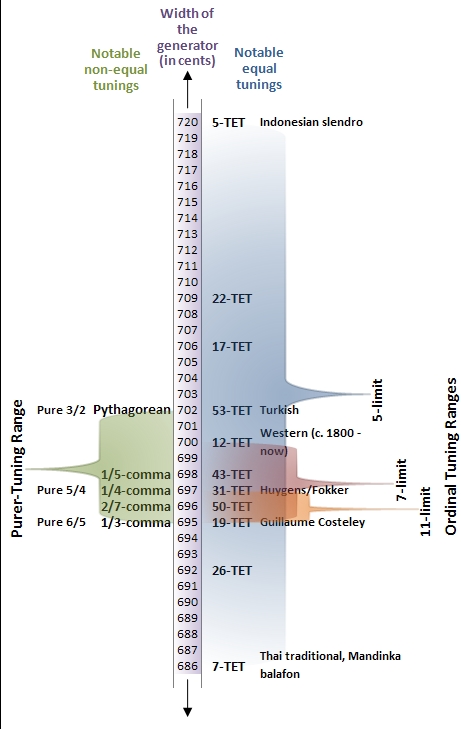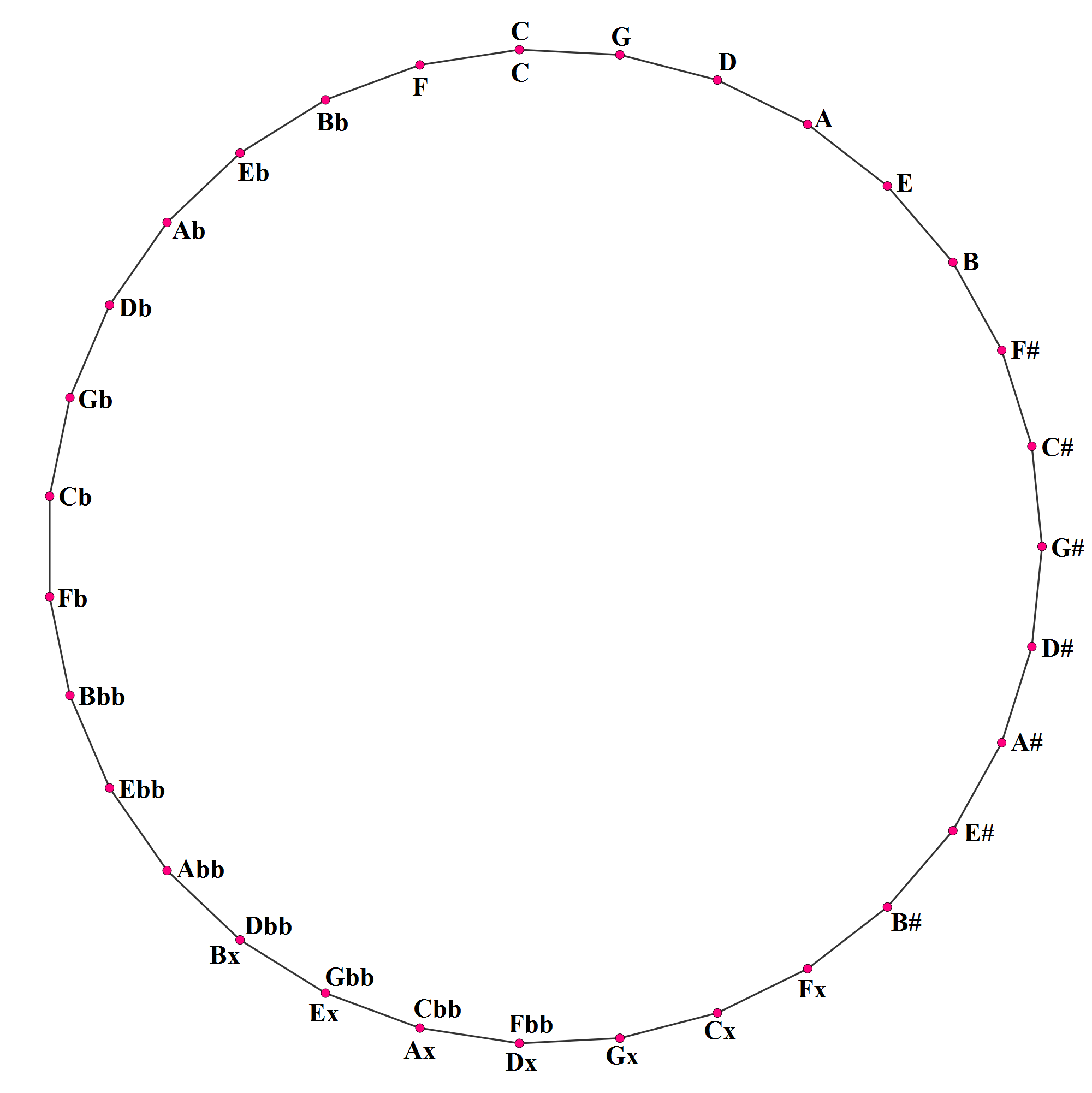31 equal temperament on:
[Wikipedia]
[Google]
[Amazon]
 In music, 31 equal temperament, 31-ET, which can also be abbreviated 31-TET (31 tone ET) or 31-
In music, 31 equal temperament, 31-ET, which can also be abbreviated 31-TET (31 tone ET) or 31-

 Usual chords like the major chord are rendered nicely in 31-ET because the third and the fifth are very well approximated. Also, it is possible to play subminor chords (where the first third is subminor) and supermajor chords (where the first third is supermajor).
It is also possible to render nicely the harmonic seventh chord. For example on C with C–E–G–A. The seventh here is different from stacking a fifth and a minor third, which instead yields B to make a dominant seventh. This difference cannot be made in 12-ET.
Usual chords like the major chord are rendered nicely in 31-ET because the third and the fifth are very well approximated. Also, it is possible to play subminor chords (where the first third is subminor) and supermajor chords (where the first third is supermajor).
It is also possible to render nicely the harmonic seventh chord. For example on C with C–E–G–A. The seventh here is different from stacking a fifth and a minor third, which instead yields B to make a dominant seventh. This difference cannot be made in 12-ET.
The Huygens Fokker foundation for micro-tonal music, in Dutch and English
* ttp://www.huygens-fokker.org/docs/rap31.html Rapoport, Paul, ''About 31-tone Equal Temperament''
Terpstra, Siemen, ''Toward a Theory of Meantone (and 31-et) Harmony''
* Barbieri, Patrizio
(2008) Latina, Il Levante Libreria Editrice * M. Khramov, “Approximation to 7-Limit Just Intonation in a Scale of 31EDO,” ''Proceedings of th
'' pp. 73–82, ABV IIITM, Gwalior, 2009.
31 Tone Equal Temperament
{{Musical tuning Equal temperaments Microtonality
 In music, 31 equal temperament, 31-ET, which can also be abbreviated 31-TET (31 tone ET) or 31-
In music, 31 equal temperament, 31-ET, which can also be abbreviated 31-TET (31 tone ET) or 31-EDO
Edo ( ja, , , "bay-entrance" or "estuary"), also romanized as Jedo, Yedo or Yeddo, is the former name of Tokyo.
Edo, formerly a ''jōkamachi'' (castle town) centered on Edo Castle located in Musashi Province, became the ''de facto'' capital of ...
(equal division of the octave), also known as tricesimoprimal, is the tempered scale derived by dividing the octave
In music, an octave ( la, octavus: eighth) or perfect octave (sometimes called the diapason) is the interval between one musical pitch and another with double its frequency. The octave relationship is a natural phenomenon that has been refer ...
into 31 equal-sized steps (equal frequency ratios). Each step represents a frequency
Frequency is the number of occurrences of a repeating event per unit of time. It is also occasionally referred to as ''temporal frequency'' for clarity, and is distinct from ''angular frequency''. Frequency is measured in hertz (Hz) which is eq ...
ratio of , or 38.71 cents ().
31-ET is a very good approximation of quarter-comma meantone temperament. More generally, it is a regular diatonic tuning
A regular diatonic tuning is any musical scale consisting of " tones" (T) and "semitones" (S) arranged in any rotation of the sequence TTSTTTS which adds up to the octave with all the T's being the same size and all the S's the being the same ...
in which the tempered perfect fifth is equal to 696.77 cents, as shown in Figure 1. On an isomorphic keyboard, the fingering of music composed in 31-ET is precisely the same as it is in any other syntonic tuning (such as 12-ET), so long as the notes are spelled properly — that is, with no assumption of enharmonicity.
History and use
Division of theoctave
In music, an octave ( la, octavus: eighth) or perfect octave (sometimes called the diapason) is the interval between one musical pitch and another with double its frequency. The octave relationship is a natural phenomenon that has been refer ...
into 31 steps arose naturally out of Renaissance music theory
Music theory is the study of the practices and possibilities of music. ''The Oxford Companion to Music'' describes three interrelated uses of the term "music theory". The first is the " rudiments", that are needed to understand music notation (k ...
; the lesser diesis
In classical music from Western culture, a diesis ( , plural dieses ( , "difference"; Greek: δίεσις "leak" or "escape"Benson, Dave (2006). ''Music: A Mathematical Offering'', p.171. . Based on the technique of playing the aulos, where ...
— the ratio of an octave to three major thirds, 128:125 or 41.06 cents — was approximately a fifth of a tone or a third of a semitone
A semitone, also called a half step or a half tone, is the smallest musical interval commonly used in Western tonal music, and it is considered the most dissonant when sounded harmonically.
It is defined as the interval between two adjacent no ...
. In 1555, Nicola Vicentino
Nicola Vicentino (1511 – 1575 or 1576) was an Italian music theorist and composer of the Renaissance. He was one of the most progressive musicians of the age, inventing, among other things, a microtonal keyboard.
Life
Little is known of h ...
proposed an extended-meantone tuning of 31 tones. In 1666, Lemme Rossi first proposed an equal temperament of this order. In 1691, having discovered it independently, scientist Christiaan Huygens
Christiaan Huygens, Lord of Zeelhem, ( , , ; also spelled Huyghens; la, Hugenius; 14 April 1629 – 8 July 1695) was a Dutch mathematician, physicist, engineer, astronomer, and inventor, who is regarded as one of the greatest scientists o ...
wrote about it also. Since the standard system of tuning at that time was quarter-comma meantone, in which the fifth is tuned to , the appeal of this method was immediate, as the fifth of 31-ET, at 696.77 cents, is only 0.19 cent wider than the fifth of quarter-comma meantone. Huygens not only realized this, he went farther and noted that 31-ET provides an excellent approximation of septimal, or 7-limit
7-limit or septimal tunings and intervals are musical instrument tunings that have a limit of seven: the largest prime factor contained in the interval ratios between pitches is seven. Thus, for example, 50:49 is a 7-limit interval, but 14 ...
harmony. In the twentieth century, physicist, music theorist and composer Adriaan Fokker, after reading Huygens's work, led a revival of interest in this system of tuning which led to a number of compositions, particularly by Dutch composers. Fokker designed the Fokker organ, a 31-tone equal-tempered organ, which was installed in Teyler's Museum in Haarlem
Haarlem (; predecessor of ''Harlem'' in English) is a city and municipality in the Netherlands. It is the capital of the province of North Holland. Haarlem is situated at the northern edge of the Randstad, one of the most populated metropoli ...
in 1951 and moved to Muziekgebouw aan 't IJ in 2010 where it has been frequently used in concerts since it moved.
Interval size
Here are the sizes of some common intervals: The 31 equal temperament has a very close fit to the 7:6, 8:7, and 7:5 ratios, which have no approximate fits in 12 equal temperament and only poor fits in 19 equal temperament. The composer Joel Mandelbaum (born 1932) used this tuning system specifically because of its good matches to the 7th and 11th partials in the harmonic series.Keislar, Douglas. "Six American Composers on Nonstandard Tunnings: Easley Blackwood;John Eaton John Eaton may refer to:
*John Eaton (divine) (born 1575), English divine
* John Eaton (pirate) (fl. 1683–1686), English buccaneer
*Sir John Craig Eaton (1876–1922), Canadian businessman
*John Craig Eaton II (born 1937), Canadian businessman an ...
; Lou Harrison; Ben Johnston Ben Johnston may refer to:
* Ben Johnston (rugby union) (born 1978), British rugby player
* Ben Johnston (composer) (1926–2019), American contemporary composer of concert music
* Bennett Johnston, Jr. (born 1932), Washington, D.C.-based lobbyist ...
; Joel Mandelbaum; William Schottstaedt", ''Perspectives of New Music
''Perspectives of New Music'' (PNM) is a peer-reviewed academic journal specializing in music theory and analysis. It was established in 1962 by Arthur Berger and Benjamin Boretz (who were its initial editors-in-chief).
''Perspectives'' was firs ...
'', vol. 29, no. 1. (Winter 1991), pp. 176–211. The tuning has poor matches to both the 9:8 and 10:9 intervals (major and minor tone in just intonation); however, it has a good match for the ''average'' of the two. Practically it is very close to quarter-comma meantone.
This tuning can be considered a meantone temperament. It has the necessary property that a chain of its four fifths is equivalent to its major third (the syntonic comma 81:80 is tempered out), which also means that it contains a "meantone" that falls between the sizes of 10:9 and 9:8 as the combination of one of each of its chromatic and diatonic semitones.
Scale diagram
The following are the 31 notes in the scale: The five "double flat" notes and five "double sharp" notes may be replaced by half sharps and half flats, similar to thequarter tone
A quarter tone is a pitch halfway between the usual notes of a chromatic scale or an interval about half as wide (aurally, or logarithmically) as a semitone, which itself is half a whole tone. Quarter tones divide the octave by 50 cents each ...
system:

Chords of 31 equal temperament
Many chords of 31-ET are discussed in the article on septimal meantone temperament. Chords not discussed there include the neutral thirds triad (), which might be written C–E–G, C–D–G or C–F–G, and the Orwell tetrad, which is C–E–F–B. Usual chords like the major chord are rendered nicely in 31-ET because the third and the fifth are very well approximated. Also, it is possible to play subminor chords (where the first third is subminor) and supermajor chords (where the first third is supermajor).
It is also possible to render nicely the harmonic seventh chord. For example on C with C–E–G–A. The seventh here is different from stacking a fifth and a minor third, which instead yields B to make a dominant seventh. This difference cannot be made in 12-ET.
Usual chords like the major chord are rendered nicely in 31-ET because the third and the fifth are very well approximated. Also, it is possible to play subminor chords (where the first third is subminor) and supermajor chords (where the first third is supermajor).
It is also possible to render nicely the harmonic seventh chord. For example on C with C–E–G–A. The seventh here is different from stacking a fifth and a minor third, which instead yields B to make a dominant seventh. This difference cannot be made in 12-ET.
See also
*Archicembalo
The archicembalo (or arcicembalo, ) was a musical instrument described by Nicola Vicentino in 1555. This was a harpsichord built with many extra keys and strings, enabling experimentation in microtonality and just intonation.
Construction
T ...
, alternate keyboard instrument with 36 keys per octave that was sometimes tuned as 31TET.
References
External links
The Huygens Fokker foundation for micro-tonal music, in Dutch and English
* ttp://www.huygens-fokker.org/docs/rap31.html Rapoport, Paul, ''About 31-tone Equal Temperament''
Terpstra, Siemen, ''Toward a Theory of Meantone (and 31-et) Harmony''
* Barbieri, Patrizio
(2008) Latina, Il Levante Libreria Editrice * M. Khramov, “Approximation to 7-Limit Just Intonation in a Scale of 31EDO,” ''Proceedings of th
'' pp. 73–82, ABV IIITM, Gwalior, 2009.
31 Tone Equal Temperament
{{Musical tuning Equal temperaments Microtonality